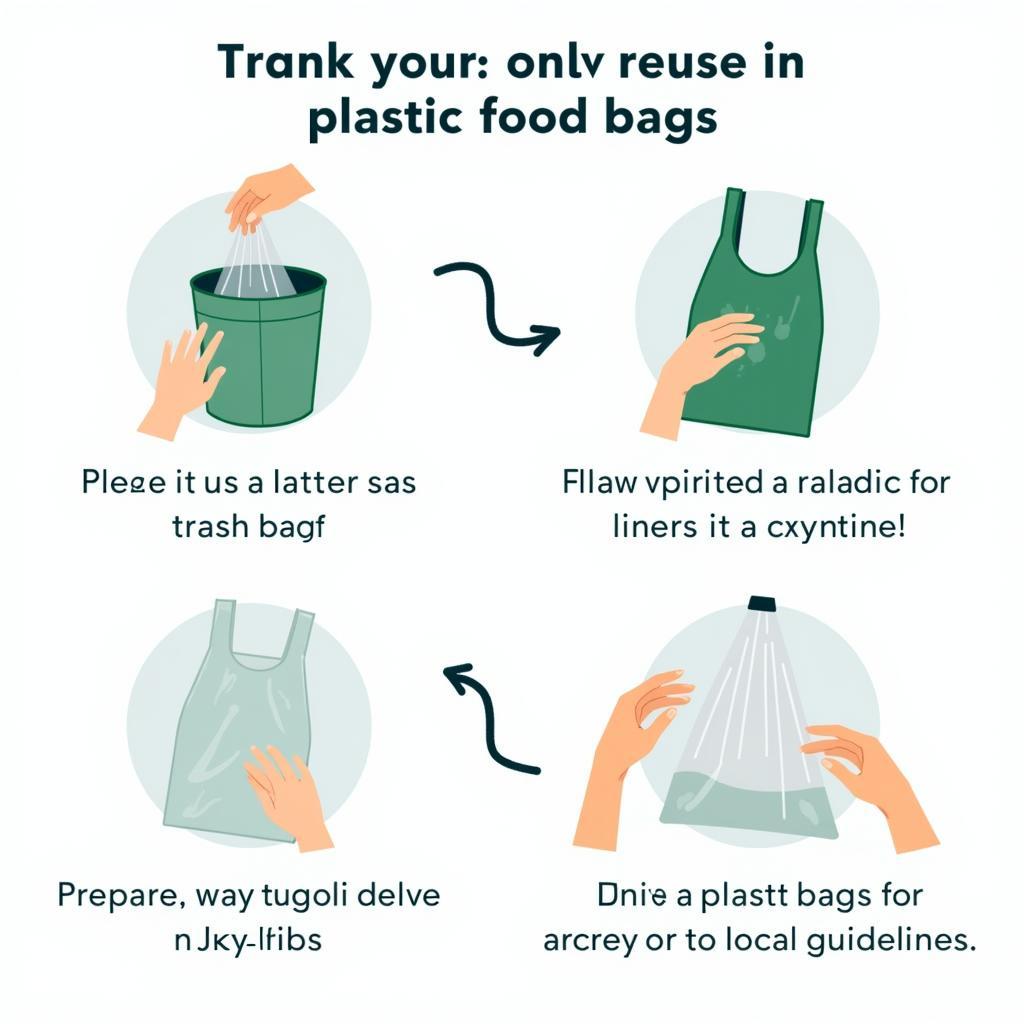Plastic Packaging Bags For Food are ubiquitous in modern kitchens and grocery stores. From preserving freshness to ensuring portion control, these versatile bags play a crucial role in our food systems. But with growing environmental concerns, it’s essential to understand the nuances of these bags, from their various types to their impact on the environment and the best practices for their usage and disposal. Check out our food storage supplies for more options.
Different Types of Plastic Packaging Bags for Food
Plastic food bags come in various forms, each designed for specific purposes. Understanding these differences can help you make informed choices about food storage and preservation.
- Low-Density Polyethylene (LDPE): These bags are flexible, transparent, and commonly used for bread, produce, and frozen foods.
- High-Density Polyethylene (HDPE): Known for its strength and rigidity, HDPE is often used for grocery bags, milk jugs, and some food storage containers.
- Polypropylene (PP): PP bags are heat-resistant and ideal for microwaveable meals and hot food storage. They are also used for packaging snacks and chips.
- Polyvinyl Chloride (PVC): While less common for food packaging now due to health concerns, PVC was historically used for cling film.
Navigating the Environmental Impact of Plastic Packaging Bags
While convenient, plastic food bags pose environmental challenges. Their production consumes resources, and their improper disposal contributes to plastic pollution. However, choosing eco friendly food packaging wholesale is an excellent alternative.
- Plastic Waste: Plastic bags can persist in the environment for hundreds of years, polluting landfills and oceans.
- Resource Depletion: The production of plastic bags requires significant amounts of fossil fuels and other resources.
- Recycling Challenges: Not all plastic bags are readily recyclable, and recycling rates for these materials remain low.
Best Practices for Using and Disposing of Plastic Packaging Bags
How can we use these bags responsibly? Here are some key tips:
- Reuse: Whenever possible, reuse plastic bags for tasks like lining trash cans or storing non-food items.
- Recycle: Check local recycling guidelines to determine if and how plastic bags can be recycled in your area. Frozen food bags are often reusable.
- Reduce Consumption: Opt for reusable alternatives like cloth bags, containers, and beeswax wraps to minimize your reliance on plastic bags.
 Reusing and Recycling Plastic Food Bags
Reusing and Recycling Plastic Food Bags
Are Plastic Food Bags Safe?
Concerns about the safety of plastic food bags are valid. Certain types of plastic may contain chemicals that could leach into food, especially when heated. However, advancements in food-grade plastics and regulations have mitigated many of these risks. Using appropriate plastics for their intended purpose is crucial. For instance, avoid heating food in bags not specifically designed for microwave use.
How to Choose the Right Plastic Food Bag?
Choosing the right bag depends on the food you’re storing and its intended use. Consider factors like temperature, moisture, and the duration of storage. For example, choose airtight food lock bags for long-term storage.
- Freezer Bags: Opt for thicker, freezer-safe bags for freezing foods.
- Storage Bags: Choose reusable zipper bags for storing pantry staples and leftovers.
- Produce Bags: Use breathable produce bags to maintain the freshness of fruits and vegetables.
Exploring Alternatives to Plastic Packaging Bags
Thankfully, numerous alternatives to traditional plastic food bags are emerging.
- Reusable Silicone Bags: These durable bags are ideal for storing snacks, sandwiches, and other food items.
- Beeswax Wraps: These eco-friendly wraps are perfect for covering bowls, wrapping sandwiches, and storing cheese.
- Glass Containers: Glass offers a safe and sustainable option for storing food in the fridge or pantry. Try using divider food containers for organized meals.
“Understanding the proper use and disposal of plastic packaging is paramount for any food enthusiast,” says Maria Sanchez, a renowned food safety expert. “While convenience is important, we must prioritize sustainable practices for a healthier planet.”
Conclusion
Plastic packaging bags for food offer undeniable convenience. However, responsible usage and exploring sustainable alternatives are crucial for minimizing their environmental impact. By making informed choices and adopting eco-conscious practices, we can enjoy the benefits of these versatile bags while safeguarding our planet.
FAQs
- Can I reuse plastic freezer bags? Yes, you can reuse them for storing non-food items or for lining small trash cans.
- Are all plastic bags recyclable? No, not all plastic bags are recyclable. Check your local guidelines.
- What’s the best way to store leftovers? Use airtight containers or reusable zipper bags.
- Are there eco-friendly alternatives to plastic wrap? Yes, beeswax wraps and reusable silicone covers are great alternatives.
- How can I reduce my reliance on plastic bags? Use reusable bags, containers, and wraps whenever possible.
- What are the different types of plastic used in food packaging? LDPE, HDPE, PP, and less commonly, PVC.
- What are the environmental impacts of using plastic food bags? They contribute to plastic pollution, resource depletion, and pose recycling challenges.
“Making small changes in our daily habits can have a profound impact on the environment,” adds Dr. James Lee, a sustainability advocate. “By choosing reusable alternatives and recycling responsibly, we contribute to a healthier planet.”
Need further assistance? Contact us at Phone Number: 02437655121, Email: minacones@gmail.com Or visit us at: 3PGH+8R9, ĐT70A, thôn Trung, Bắc Từ Liêm, Hà Nội, Việt Nam. We have a 24/7 customer support team.